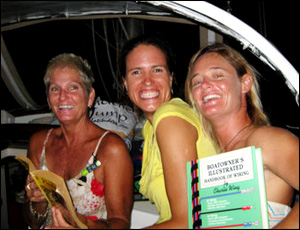Heather McCarthy has been sailing with her husband, Dan, and their three daughters, the “McMermaids” since 2011. They are currently cruising the Florida Keys, Dry Tortugas, and the Bahamas onboard s/v Jullanar.
Here, Heather answers a few questions about how solar cooking has opened up a whole new suite of cruising food options for her family.
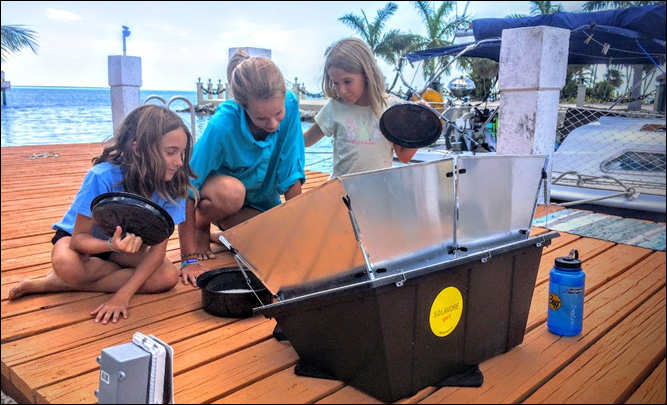
The McMermaids (Calypsa, Jelena, and Marina) are preparing to solar-cook white rice and chocolate-chip blondies. Summerland Key, Florida.
Photo taken by Heather McCarthy.
CULINARY QUESTIONS
What kinds of foods do you cook in your solar oven?
I love to prepare dishes in the solar oven that I wouldn’t dare cook on my galley’s 2-burner propane stove – foods that require long cooking times like rice, dried beans, roasted meats and vegetables, potatoes, stews, chili, etc.
I feel great about saving propane and sparing everyone from the “dinnertime sweat” by keeping the boat cool in the late afternoon.
Our sailboat does not have a propane oven, so I use the Solavore Sport solar oven to do ALL baking – bread, cakes, scones, muffins, cookies, pizza, pies, etc. I have tried stovetop ovens with little success – some part of the dish usually burns. However, the baked goods coming out my solar oven never burn and are always crowd-pleasers!
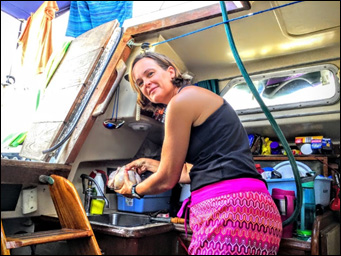
In the galley of s/v Jullanar, Heather is preparing a small, 4-pound whole chicken to roast in the solar oven.
Photo taken by Calypsa McCarthy
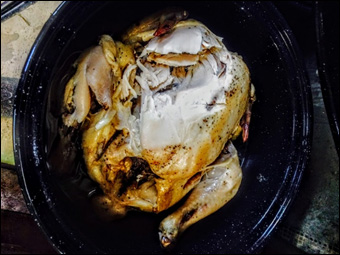
The golden, juicy roasted chicken after 4 hours at 275°F in the solar oven! My kids said it was the best chicken they’ve ever had! Summerland Key, Florida.
Photo taken by Calypsa McCarthy
What kinds of adaptations do you make to your recipes for cooking in the solar oven?
A solar oven cooks like a crockpot or slow cooker (low temperature, long cooking durations). While the boiling point of water (212°F) is achieved, very little water evaporation takes place.
That means that you can and should add slightly LESS WATER to your rice/grains, dried beans, chili, stew, and soup recipes. One cup of jasmine rice to 1 2/3 cups of water turns out perfect for me every time.
You don’t need to add ANY WATER to cook hard-boiled eggs, corn-on-the-cob, potatoes, and other vegetables that you might boil in a pot a water on the stovetop.
Can you bake bread in it? If so, how long does that take?
Oh yes! Bread baked in the solar oven is delectable!!!
I have had excellent results with basic white bread, cornbread, and a variety of sweet breads like pumpkin or banana breads. I try to keep the loaf size small, or spread the recipe between the two black granite-ware pots to keep cooking times shorter.
Cooking times depend on the internal temperature of the solar oven, which, of course, depends on the sun’s intensity at the time. For baking, I want the solar oven to be in its highest temperature zone when I place the dough into the oven – at least 275°F.
I achieve this in two ways:
- Pre-heat the oven for 20-30 minutes,
- Use the reflectors – the more light rays diverted into the oven, the hotter it will get!
Today, I cooked a small loaf of garlic and herb bread in 60 minutes with reflectors on and an internal temperature of 300°F. Everyone on the dock was salivating as they could smell it baking!
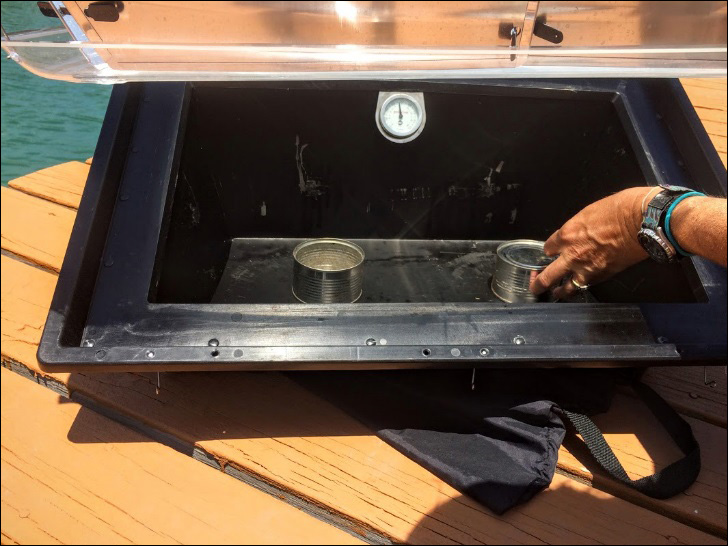
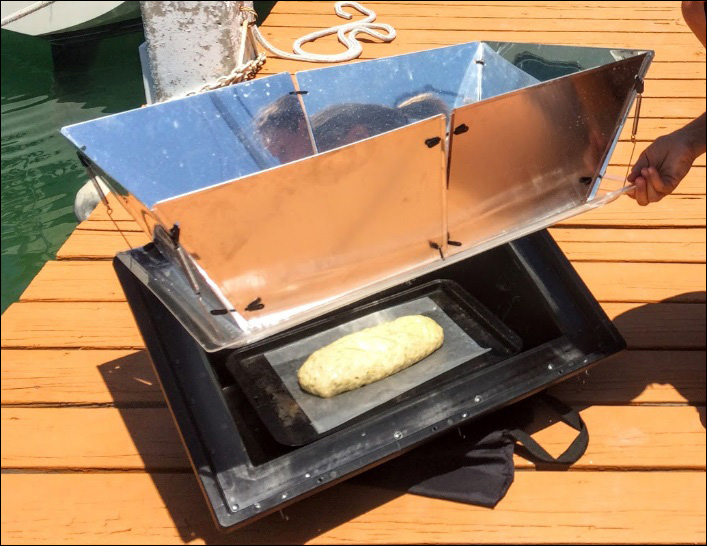
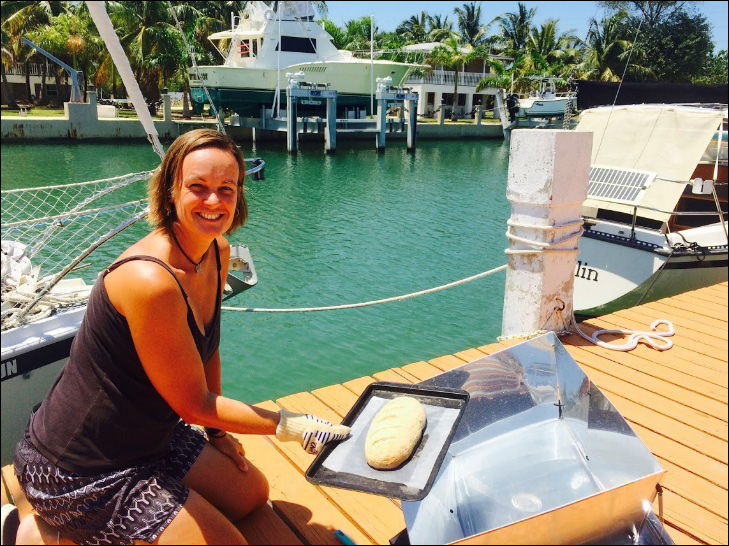
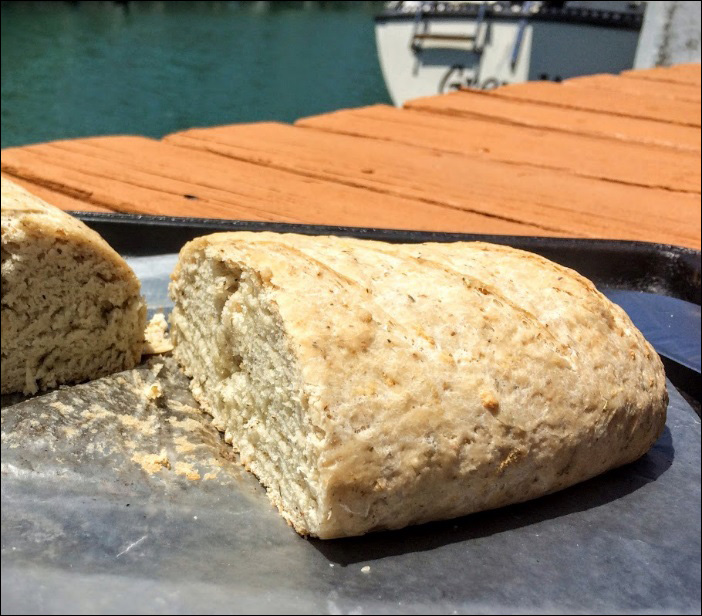
Baking bread in the solar oven is easy!
Use a bread loaf pan, split the dough between the two graniteware pots, or place the loaf on a cookie sheet. An 11” x 17” cookie sheet fits nicely in my solar oven, when raised up on two empty tuna cans. You can fit a muffin pan into the oven in this way too.
Summerland Key, Florida.
Photos taken by Calypsa McCarthy.
How long does it typically take you to cook a casserole, rice and beans, stew, etc.? What time of day do you typically place your dish in the oven?
When estimating cooking times of dishes such as these, try to change your mindset from “oven” to “crockpot.” Think about how your crockpot at home has time settings like 4, 6, 8, 10 hours – these are comparable to solar-cooking times. My crockpot at home cooks at 200°F on its “HIGH” setting. At 275°F, the solar oven cooks rice in about 1 ½ hours, roasts a whole 4-lb chicken in 4 hours, and cooks dried beans (soaked overnight) in about 6 hours.
As long as you start thinking in the morning about what you want to cook for dinner, you can ensure that you have you enough time.
If I am going to cook roast beef, pulled pork, or a whole chicken, I’ll need to start the cooking at about 10:00am, in order to give the dish up to 6 hours of bright sun to fully cook. Occasionally, my kids have begged to eat at 4:00pm, because dinner was basically done in the solar oven and smelled so good! Why not!?!
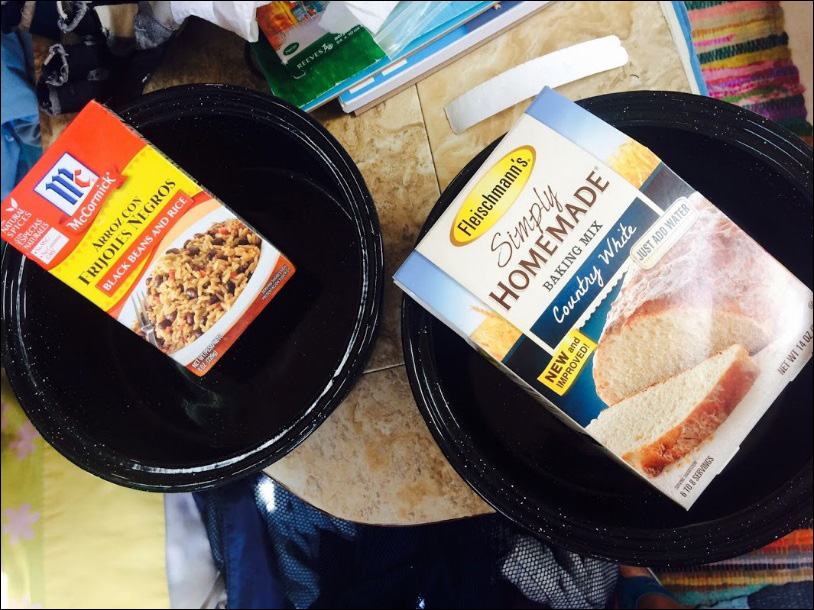
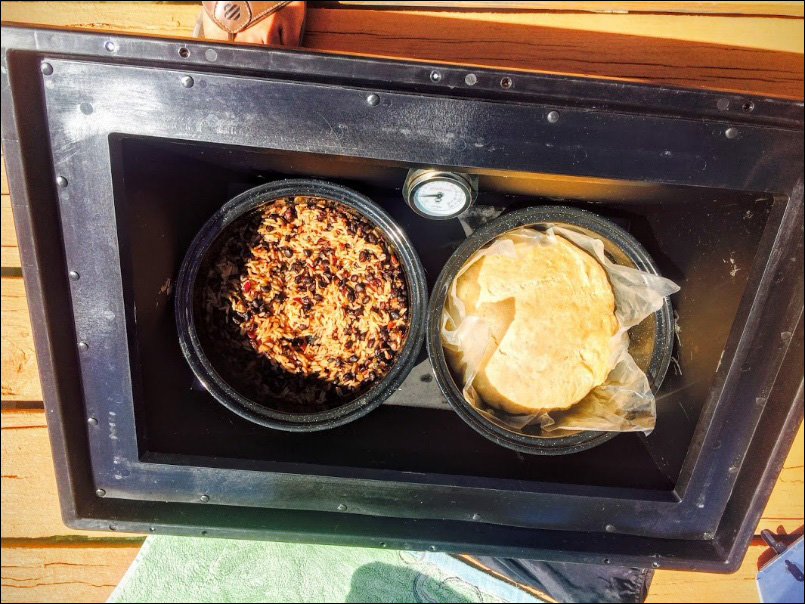
When cruising with three children gets a little crazy, I simplify meals by cooking box mixes like these in the solar oven. Here are “before” and “after” photos of boxed rice and beans and country white bread. I place baked goods on a sheet of wax/parchment paper for easy removal and clean-up. Summerland Key, Florida.
Photos taken by Calypsa McCarthy.
How often do you have to finish cooking a recipe on your propane stove or propane oven?
In this regard, solar cooking is a bit like cruising – if you try to force things in less-than-ideal weather, less-than-ideal things will happen!
I did this once…. A week in advance, I invited guests over for a Saturday night meal of “solar-cooked pulled pork and rosemary scalloped potatoes.” Well, Saturday ended up being a cloudy day, and the pork didn’t cook. It went back in the refrigerator to wait for a sunny day, and we ordered pizza for dinner!
Just watch the weather and pick sunny days (air temperature doesn’t really matter), and you will rarely (if ever) have to finish a dish using propane.
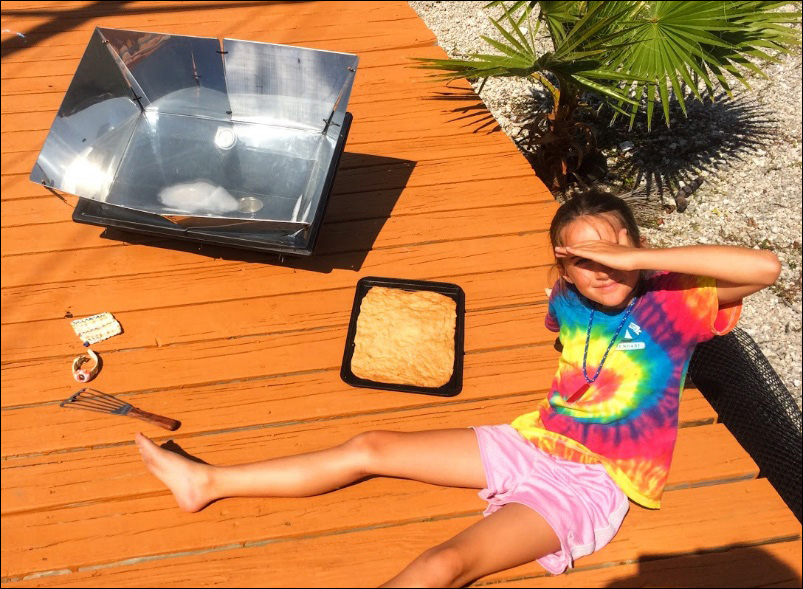
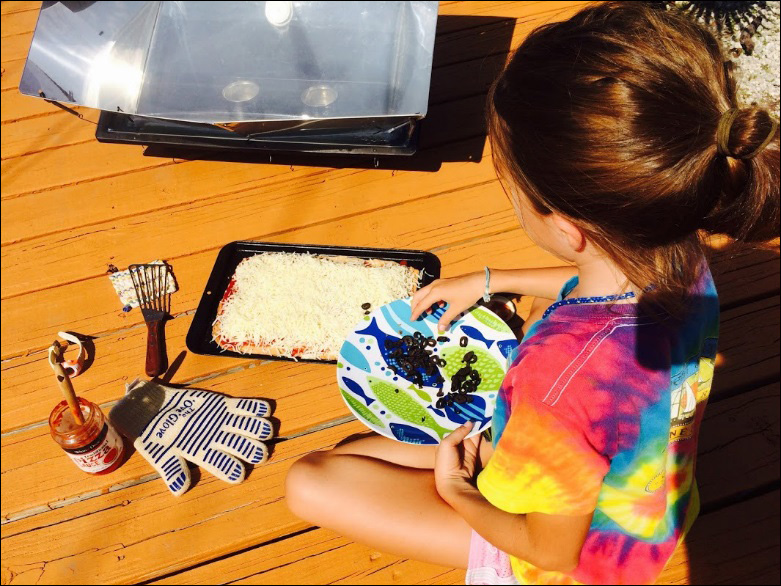
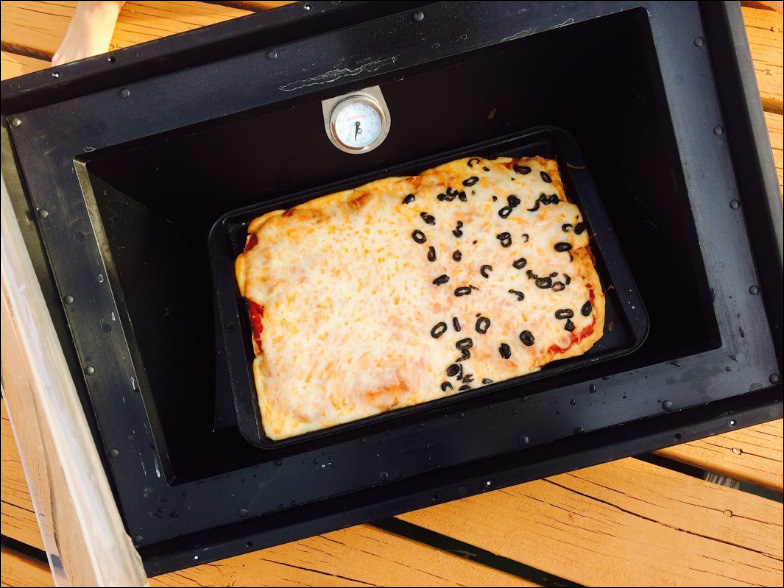
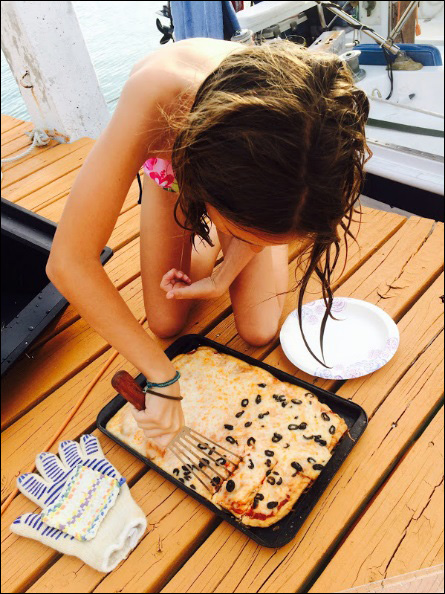
When baking pizza in the solar oven, our results are fantastic when we brown the crust first. Then, add sauce, cheese and toppings, and bake until the cheese is melted and bubbly. Summerland Key, Florida. Photos taken by Heather McCarthy.
SAFETY QUESTIONS
How hot does a solar oven actually get?
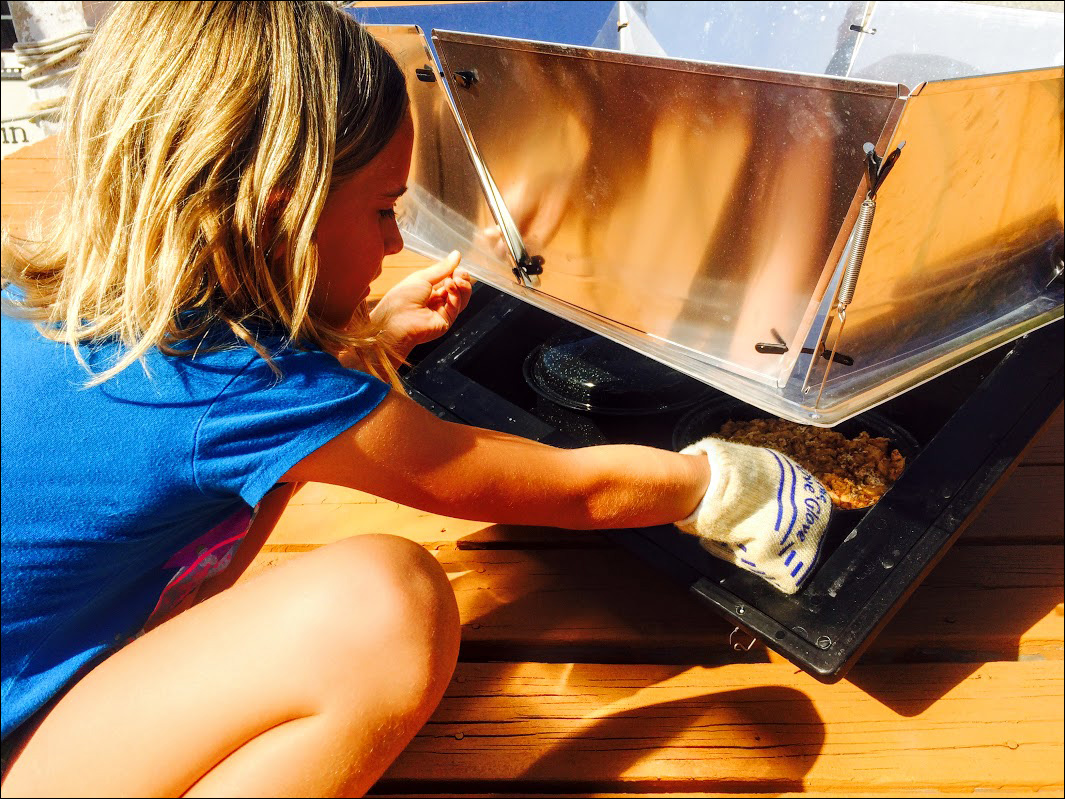
Our youngest McMermaid (8 years old) baking an apple pie in the solar oven. You can see that the lid of the oven is cool enough that she can touch it with her bare hands, while handling the pots inside requires an oven mitt – the pots and food are very hot at around 300°F.
The Solavore Sport is engineered to withstand temperatures up to about 325°F. I like to keep an eye on the oven temperature gauge, and if it starts to climb above 325°F (I’ve seen it do this on very hot, sunny Florida days), I just take the reflectors off or turn the oven slightly away from the sun to bring down the temperature.
Does the solar oven get hot on the outside? Do you have to place something under the oven in order to cook on your deck?
When cooking, the black, exterior base of the oven feels barely warm to the touch. This oven’s thick insulation keeps the heat inside, and the outside stays cool. The lid can feel slightly warmer, but we can still comfortably lay our hands on it.
I have no fear of my kids playing right beside the oven, and I can cook directly on my boat’s deck without anything under the oven.
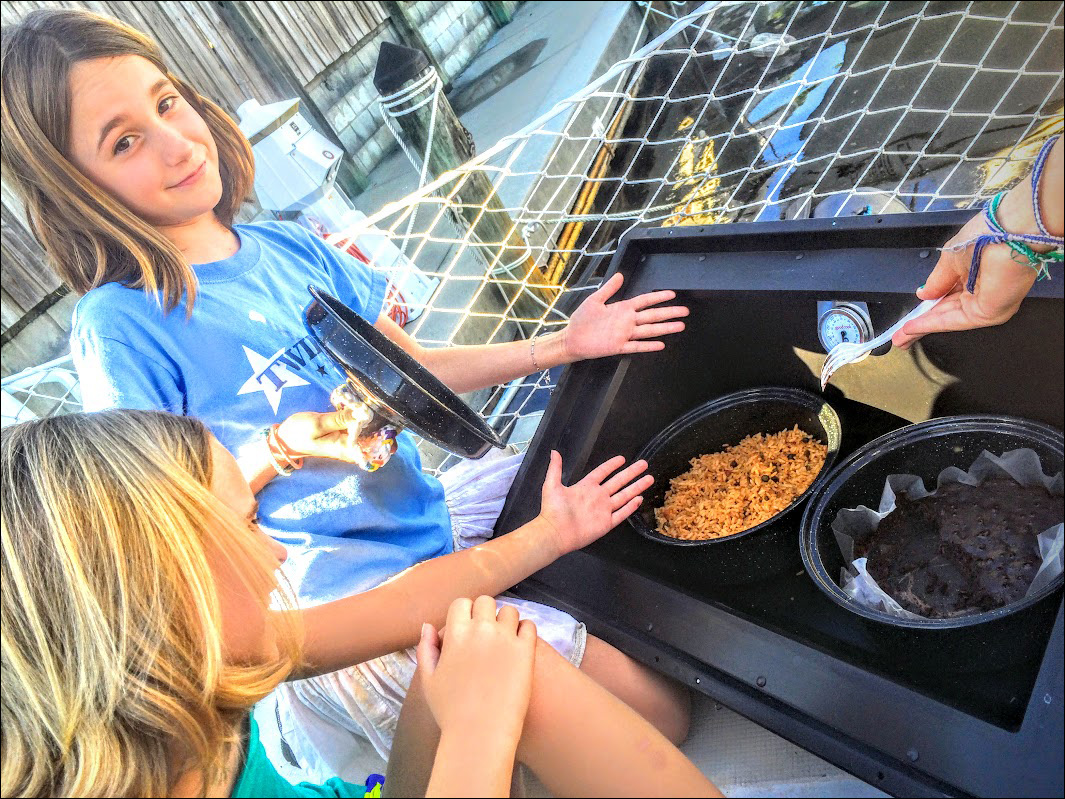
McMermaids cooking directly on the foredeck of s/v Jullanar – Spanish rice and brownies! The outside of the oven stays cool to the touch. The kids just had to “test” the brownies to make sure they were done! Eau Gallie Yacht Basin, Melbourne, Florida. Photo taken by Heather McCarthy.
Can solar cooking start a fire or burn food?
I can’t imagine a scenario in which the Solavore Sport could start a fire. The average internal temperatures (225-275°F) of the oven are low enough that it is extremely safe. Even if a piece of paper accidentally found its way inside the oven with your food, it would not catch on fire (it’s easy to remember the average temperature at which paper catches fire and burns, because author Ray Bradbury named his famous book after that temperature — Fahrenheit 451).
Likewise, the relatively low cooking temperatures of this oven prevent foods from burning.
Believe me, I’ve tested this! When I first started using this solar oven, everything cooked faster than I expected, so I ended up with a couple over-cooked, yet quite edible, dishes. Learn from my experience…. Cookies bake FAST (20-30 minutes), but, if left in too long, they simply turn dark golden and crunchy — still yummy!
My best example is banana bread that I forgot about and left in for 4 hours (it cooks in 1 hour). When we tasted the golden banana bread, we realized something magical had happened! The bread wasn’t dried out or burned, but the sugars had caramelized! This created a delicious, new, caramel-flavored banana bread!
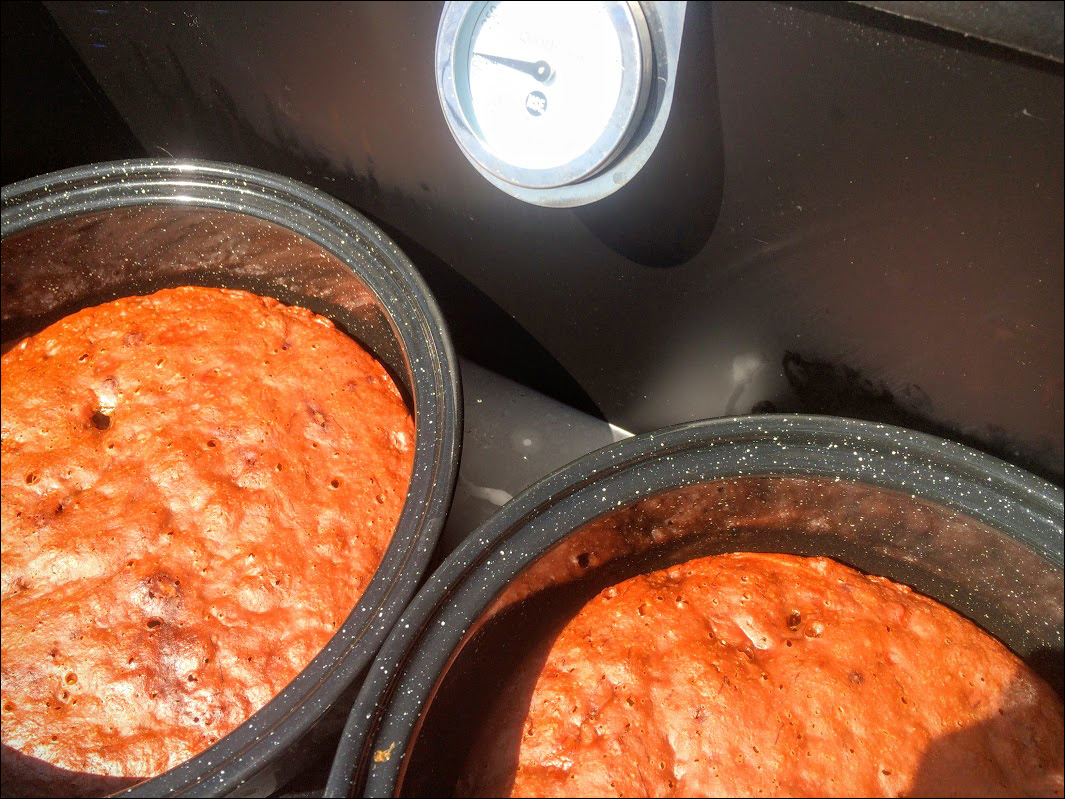
Not burned! Banana bread left in the oven too long did not burn or dry out, but the sugars caramelized into a moist, delicious “new” flavor!
LOGISTICAL QUESTIONS
Where do you store your solar oven aboard? Can you store it on deck?
I’m often asked questions about storage! When bringing any item onboard, every cruiser has to carefully consider the value of the item versus the space required to store it. We REALLY do — we’ve got five people cruising full-time for six months onboard a 29′ sailboat.
In response, I love this quote from s/v The Red Thread’s blog regarding a wafflemaker… “The last thing we wanted was to weigh down The Red Thread by hoarding unnecessary nonsense. “HOLD IT – doesn’t a waffle iron fall into the unnecessary nonsense category?” you ask. Well, I suppose it depends on how much you like breakfast!”
Same idea with the solar oven — I LOVE solar cooking, so I’m going to make room onboard for my solar oven. I derive great rewards from using and teaching others about the fuel-free, planet-friendly, time-saving power of the sun! So, for me, it’s worth the space sacrifice.
My Solavore Sport oven weighs 9 pounds and measures 12 ¼” high by 27 ¼” long by 17” wide. The reflectors fold flat and fit nicely inside the oven with the two pots. I store the whole unit in a pillowcase on top of the engine when stopped and on the aft berth when underway. If you have a place on your deck out of the rain and sun, you could store it there.
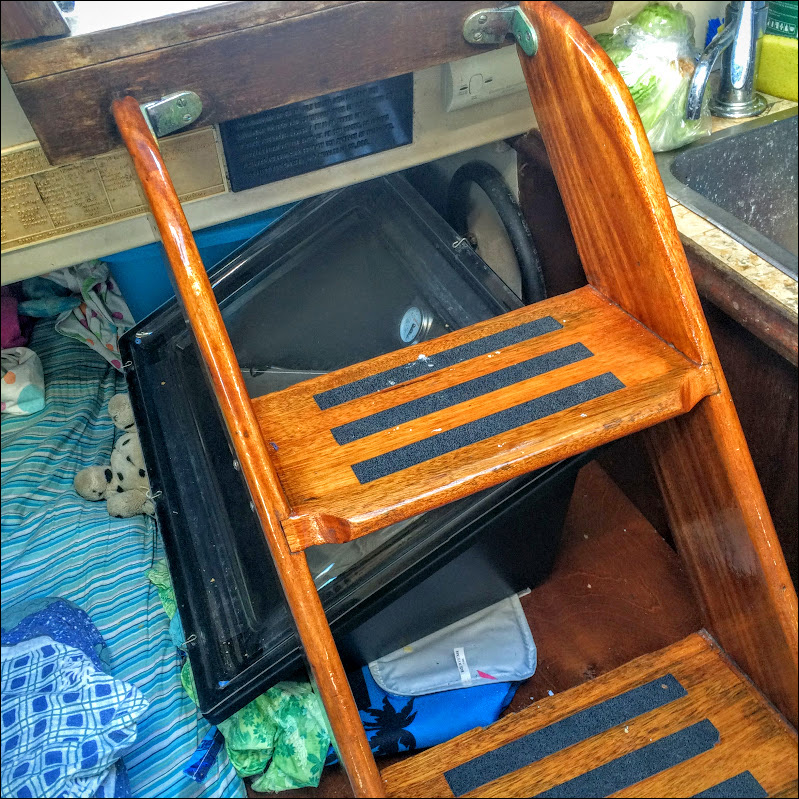
When docked or anchored, we store our oven under the companionway on top of the engine cover in our 29’ Ericson sailboat. When underway, we store it on the aft berth. Summerland Key, Florida. Photo taken by Heather McCarthy.
I’ve brainstormed with clever cruisers about creative ways to
a) mount it like a grill on the stern rail (when not cooking, the oven should be upside-down to prevent rain or saltwater from getting in), and
b) suspend the oven from davits or some other part of the boat that allows you to rotate the hanging oven while cooking to follow the sun.
I’m sure fellow cruisers can come up with other ingenious storage solutions!
Could you use the solar oven underway? How do you cope with wind?
I prefer to solar cook when we are tied up at a dock, a marina, or anchored out. I usually place the solar oven on the bow of our sailboat or on the dock beside it.
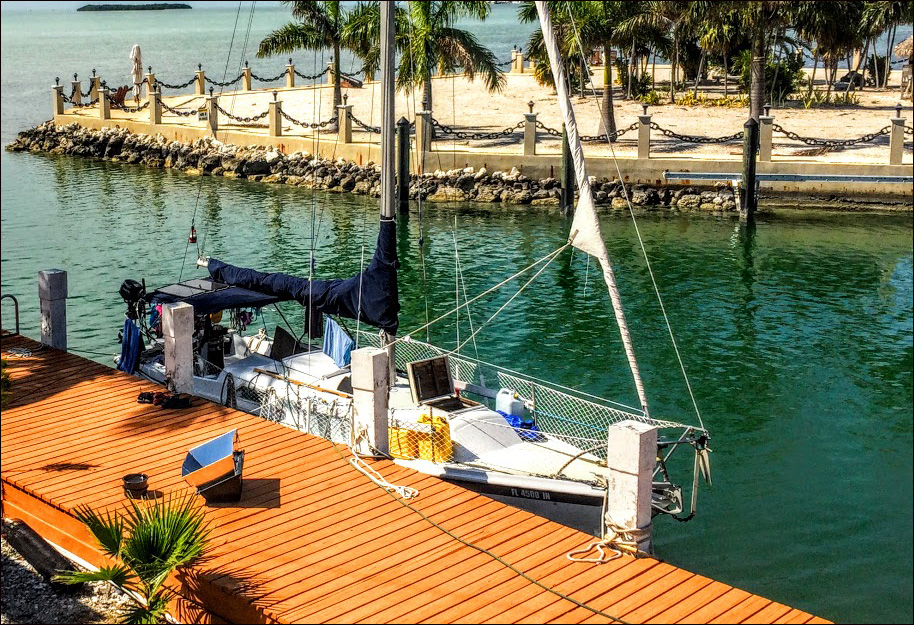
An aerial view of our oven pre-heating on the dock next to our sailboat s/v Jullanar.
I suppose you could use the solar oven underway, if you found yourself in a stable situation like a flat day on the ICW. I would be more inclined to cook quick, non-liquid dishes while underway – like cookies, which bake in 20-30 minutes. I wouldn’t want to be cooking a soupy dish, if there was any chance of getting hit by a rogue wave or an unexpected boat wake that would cause the dish to spill.
Does Solavore sell a smaller solar oven?
Great question — I, too, wondered if it was possible for Solavore to make a smaller one-pot version, so I asked the CEO!
At this time, the answer is no, because a minimum number of light rays are needed to get the oven to cooking temperature. As designed, the convex surface area of the lid gathers and concentrates enough light beams to reach adequate temperatures. Let’s say the surface area of the lid was reduced to half its current size to make the oven half as big (imagine a one-pot version)… Reflectors would be a MUST, and they would have to be twice as big to gather in and concentrate the same number of light rays to get the smaller oven to cooking temperatures. Huge reflectors are difficult to stow and cannot be used during windy conditions.
So, the engineers of the Solavore Sport came up with a design that balances size, usefulness, storability, and cooking effectiveness.
How much does a Solavore Sport cost? Where can I order one?
For current pricing and shipping information and to find out more about Solavore’s humanitarian missions around the world, please check out Solavore’s website. To make sure you don’t miss out on any special sales or promotions, sign up to receive the monthly newsletter and follow Solavore on Facebook, Twitter, Instagram, and Google+.
Thank you so much for the opportunity to share solar cooking with other fellow cruisers!
About Heather P. McCarthy
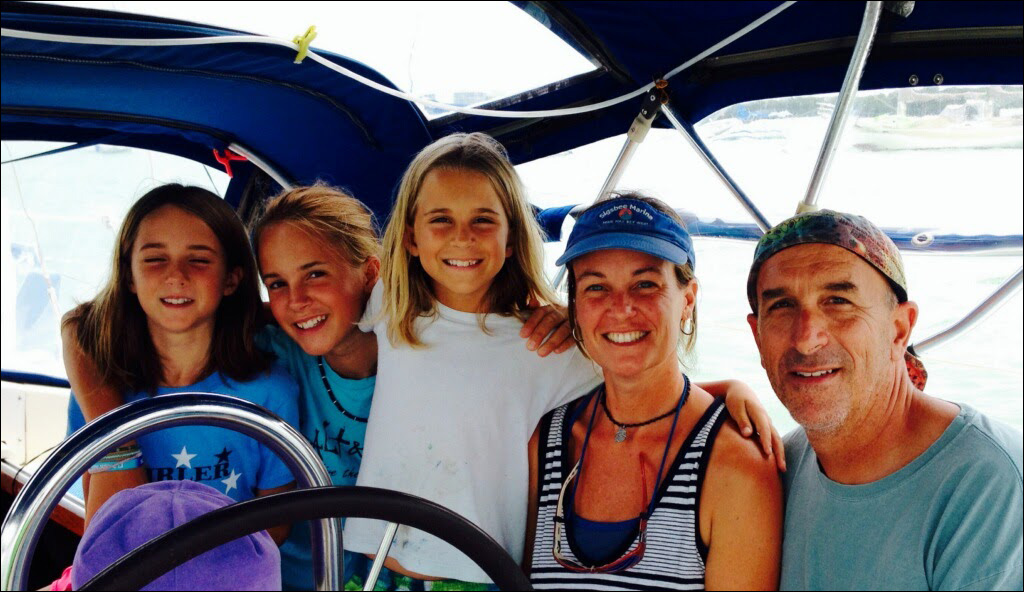
The McMermaids (Calypsa, Jelena, and Marina) with Heather and Dan McCarthy, Boot Key Harbor, Marathon, Florida. Photo taken by Joe Holland.
Heather McCarthy of Jacksonville, Florida, has been sailing with her husband, Dan, and their three daughters, the “McMermaids” since 2011. During their first two years of sailing, this family-of-five traveled on s/v Marcalena, a small, galley-less 25’ MacGregor sailboat.
During a two-week trip in the Florida Keys on this boat, Heather cooked meals for her family on a shoreside campstove and dreamed of a solar oven that would allow her to snorkel all day with her family and come back to a delicious-smelling, fully cooked dinner! She tried (unsuccessfully) to build homemade solar cookers, but, even after rounds of modifications, her drippy, hungry kids just kept coming back to crunchy beans and rice.
However, there was no shaking the notion of solar cooking out of her head! She did her research on the sailing/boating blogs, found herself inspired by The Boat Galley, Women and Cruising, and Sailing Totem (“Seriously? Roast a whole chicken!?!”), and decided to get a Solavore Sport Oven – the model that kept popping up as “tough enough” for boat life.
Heather and her family are currently on a six-month sailing sabbatical onboard s/v Jullanar, their 29’ Ericson sailboat, dining on scrumptious solar-cooked cuisine, while traveling Florida’s Atlantic coast, the Florida Keys, and the Bahamas.
Their blog is at: mcmermaids.com
Learn more
- Cruiser Anne Patterson makes solar ovens … And shares a recipe
- Good Cookin’: Why I Love my Solar Oven, by Ann Patterson
- Solavore’s website & Solar cooking recipes
- Cooking with a Solar Oven aboard, by Behan Gifford, s/v Totem

